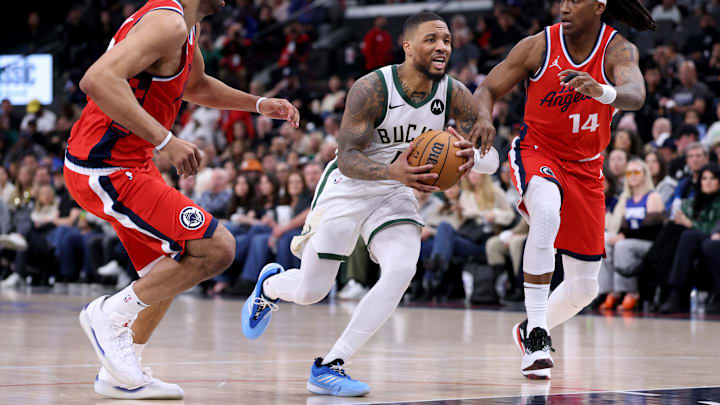In the year since Adrian Griffin was replaced by Doc Rivers, the Milwaukee Bucks roster has remained cosmetically identical while the results have yielded two steps forward and two steps back. A 2-8 start was followed by a 23-10 record since, good for fourth in the East.
After Saturday night's loss to Giannis Antetokounmpo's longtime archrival James Harden and the Los Angeles Clippers ended the NBA's longest active winning streak, their current sub-58 percent winning percentage record and 0-8 against the top teams in their conference points to regression since their 68 percent winning percentage a year ago when the sky was falling.
Something's got to give and soon. Eleven players return from last year’s roster and Rivers, which is both a blessing and a curse. That roster inertia gave them stability after a destabilizing offseason the year prior. At the same time, their status as a second-apron luxury tax team limited their off-season flexibility. It's been a year Sunday since Rivers' hiring and it's been disorienting to watch them run in place.
Bucks offense: Then and now
The Bucks won a title playing at one of the league’s fastest paces in 2021. Rivers took command, he reduced the offensive MPH to below the league’s speed limit, and their offense cratered to a perfectly average 15th in offensive efficiency. This season, they’ve recovered some semblance of balance as a top-10 offense without sacrificing their defense on the altar. They’re fourth in effective field goal percentage and sixth in effective field goal percentage allowed.
Last season, Malik Beasley knocked down the 10th most 3-pointers in the league, shooting better than 40 percent from the field, but was a gaping liability defensively. After allowing him to decamp, the Bucks turned to guard Gary Trent Jr. in free agency. While Trent is an equal to Beasley’s sharpshooting, he is an unspectacular, but still more disciplined defender than Beasley. Marksman guard A.J. Green’s minutes doubled in his third season, and he’s thrived in a larger role shooting 44 percent from downtown.
Offseason additions like Delon Wright and the enhanced role of second-year Andre Jackson Jr., a big athletic playmaking forward and secondary ball handler who plays asphyxiating defense have improved the Bucks' dreadful perimeter defense
Bucks rebounding: Then and now
One area the Bucks still must improve in is on the offensive boards where they rank dead last in the league after finishing 26th in offensive rebounding percentage a year ago. The Bucks have plenty of size to compete on the glass. On the defensive boards, they’re the NBA’s best. Antetokounmpo and Lopez are two of the fiercest glass cleaners in the league. Bobby Portis is no slouch. However, early season transition defensive woes led to the Bucks getting back after a shot goes up instead of crashing the boards once a shot goes up, limiting their proficiency in garbage collection of long misses or around the paint. Somehow they have to discover the harmony between crashing the boards and playing competent transition defense.
Bucks defense: Then and now
Since 2010, only two teams have won an NBA title ranked outside the top 10 in defensive efficiency. During the final four seasons of Mike Budenholzer’s stint as head coach, Milwaukee ranked first, ninth, 14th, and fourth in defensive rating with Lopez in drop coverage. The paucity of perimeter security coupled with Lopez’s mismanaged role resulted in a fractured defense.
Despite rumors of blockbuster acquisitions or jettisoning Bobby Portis, Brook Lopez, or Khris Middleton, their core remains intact for now. Rivers’ greatest contributions to the Bucks came early in his tenure when he began deploying Brook Lopez in a manner that he was accustomed to.
Since Lopez was signed by Milwaukee in 2018, Lopez has established himself as an All-Defense rim protector in a scheme that dropped him back defending pick-and-rolls. Under Griffin, a late-30s Lopez was asked to play matador against probing wings and guards, stepping up to defend drivers and provide help defense for their turnstile guards in the wake of Jrue Holiday and Grayson Allen’s departure.
Currently, the Bucks are the league’s ninth best defense and allowing fewer forays into the paint than a year ago when they surrendered 44.8 drives per game. This season, they are closing out better, and allowing just 35.8 drives, the second-fewest drives in the league behind Denver.
At the time of Griffin’s firing, the Bucks were a BOTTOM-10 team in defensive field goal percentage, defensive rating being carried by the third-highest scoring offense, tallying 120 points per 100 possessions. Even after Rivers assumed the reins and oversaw an overhaul of their coverages allowing Lopez to play to his strengths, they were the league’s 15th-best defense in the second half of the season, per Cleaning the Glass, the lowest they’ve ranked in the Lopez era. Their aforementioned personnel shortcomings on the perimeter played a significant part.
The most visible change to the roster is the absence of Thanasis Antetokounmpo, the bench mob's ordained leader. Antetokounmpo is rejuvenated on both ends and has unlocked his midrange game. The Bucks are still staring up at the Eastern Conference aristocracy and at a glance, their record doesn’t inspire great confidence, but progress is being made. As the trade deadline approaches, they’ll likely have to shift the tectonic plates in a bold way to shatter the barrier separating them from the contender's class.
